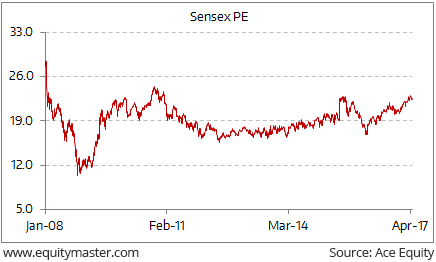Indian share markets continued to trade range bound in the afternoon session and finished marginally lower due to selling in healthcare stocks, capital goods stocks, and energy stocks amid negative global cues.
At the closing bell, the BSE Sensex stood lower by 26 points, while the NSE Nifty finished down 2 points. Meanwhile, the S&P BSE Mid Cap and the S&P BSE Small Cap finished up by 0.1% respectively.
Ten Year Sensex PE

The BSE Sensex recently closed comfortably above the magic figure of 30,000 for the first time. The midcap and small-cap indices are trading at quite high valuations.
Here’s what Tanushree wrote about valuations and returns:
The current valuation of the index – more than 22x – is rare. Over the past two decades, the NSE Nifty has traded above 22x only nine times. And when it does, buying even the biggest blue chips has come with a huge downside for long-term investors. On five out of the nine occasions, the index lost money over a two-year period. So the historical data suggests there is currently a 60% chance of losing money in bluechip stocks.
But it’s better to forget the indices and use a bottom-up (a stock-specific) approach.
This is the StockSelect team’s approach. They focus on the underlying business. Its earning power, the business model, growth opportunities, and valuations.
Asian markets were mixed on Wednesday, as gains on Wall Street overnight were offset by disappointment with Apple earnings, with traders looking ahead to the U.S. Federal Reserve meeting results. The Nikkei 225 gained 0.70% and the Hang Seng rose 0.33%. The Shanghai Composite lost 0.27%. European markets are lower today with shares in France off the most. The CAC 40 is down 0.31% while London’s FTSE 100 is off 0.29% and Germany’s DAX is lower by 0.21%.
The rupee was trading at Rs 64.14 against the US$ in the afternoon session. Oil prices were trading at US$ 47.99 at the time of writing.
Global ratings agency Fitch Ratings has retained ‘BBB-‘ ratings – the lowest investment grade – with a stable outlook for India citing weak fiscal position and difficult business environment. The agency forecast real gross domestic product (GDP) growth to accelerate to 7.7% in both 2016-17 and 2017-18, compared with 7.1% in 2015-16. It also expects India’s current-account balance to narrow to -0.9% in FY17, and foreign reserves to build up to 8.4 months of current external payments.

